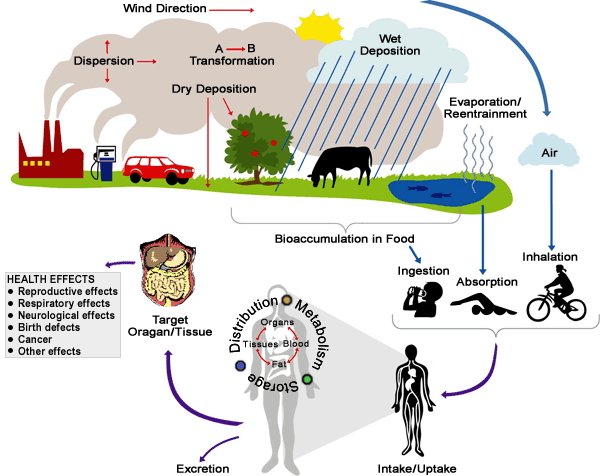Air toxics, also referred to as hazardous air pollutants (HAPs), are substances that are known or suspected to cause serious health effects including:
- Cancer, and
- Non-cancer health effects including birth and developmental defects, blood disorders, damage to the nervous system, damage to the immune system, damage to the reproductive system, and damage to the respiratory system.
Exposure to (coming in contact with) air toxics also may cause relatively minor, temporary health effects, including skin irritation, headaches, nausea, eye, nose and throat irritation, difficulty breathing, coughing, behavioral changes, and fatigue. The primary ways people may be exposed to air toxics include:
- Breathing in chemical vapors and contaminated dust (inhalation),
- Drinking or eating chemical contaminants (ingestion), and
- Absorbing chemicals through the skin (absorption).
The ability of a toxic compound to access and affect different organs depends on several factors including:
- Exposure, such as the way in which we are exposed and for how long (the duration of exposure),
- Concentration, which generally refers to the amount of a substance in a sample of air. and
- The chemical’s toxicity, which is how harmful the compound is to human health. Generally as toxicity, concentration and duration of exposure increase, so do health risks.
A toxic compound that enters the body may be excreted, or exit the body, through the respiratory system (exhalation), the digestive system, or the skin (perspiration). However, compounds that enter the body may circulate in the bloodstream, be carried to different organs, undergo chemical changes in the body (to become more toxic or less toxic), and cause a number of different cancer and non-cancer effects. Depending on the chemical, acute (short-term) and/or chronic (long-term) exposure may result in immediate (acute) and/or long-term effects.
In the environment, air toxics may disperse and/or transform into other toxic compounds. For example, contaminated particles may settle out of the air onto soil or water (dry deposition). Precipitation such as rain, snow and fog may wash compounds from the atmosphere into soils, lakes and rivers (wet deposition). Pollutants may evaporate from soil and water into the atmosphere. Certain toxic compounds that deposit onto soils or surface waters, such as mercury, may be taken up by plants, ingested by animals, and eventually magnified up through the food chain. Like humans, animals may experience health problems if exposed to sufficient quantities of air toxics.
The diagram below helps illustrate how chemicals may enter the environment, how people may be exposed, and potential health effects that may result.

Section 112 of the federal Clean Air Act (CAA) requires the reduction of air toxics from human sources and provides an initial list of 189 compounds, which U.S. EPA has modified to the current list of 187 regulated air toxics. U.S. EPA’s Health Effects Notebook for Hazardous Air Pollutants provides fact sheets on the health effects of hazardous air pollutants (HAPs). Regulation for air toxics and sources include U.S. EPA’s National Emissions Standards for Hazardous Air Pollutants (NESHAPs) and state rules in Title 326 of the Indiana Administrative Code (326 IAC). U.S. EPA regulates mobile source emissions from motor vehicles, which are a significant source of air toxics in the ambient outdoor air.
IDEM’s Air Toxics Program has an important role in understanding and reducing potential health risks in urban areas from the cumulative effects of combined exposure to air toxics from all sources.
